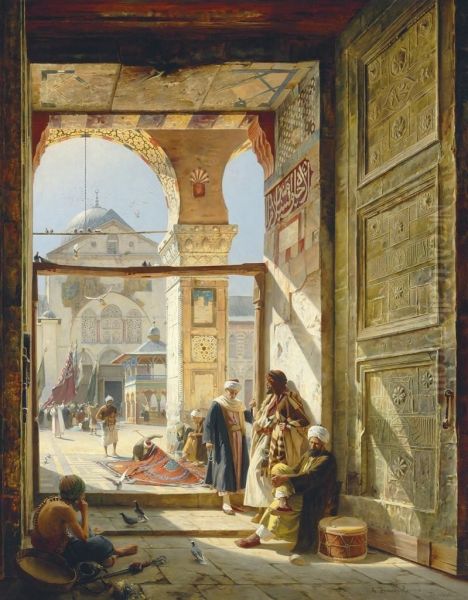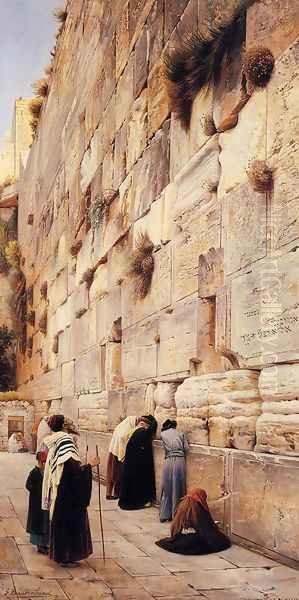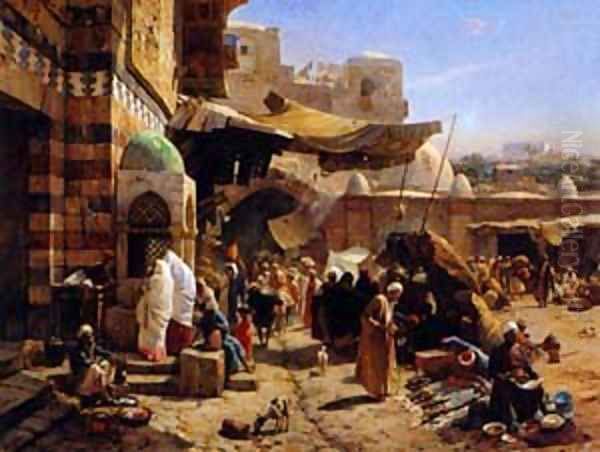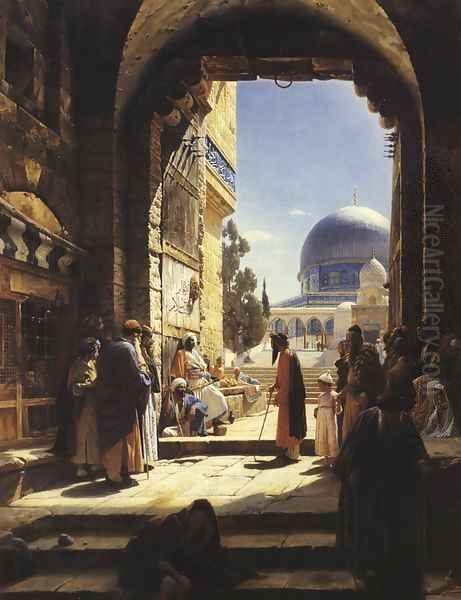Gustave Bauernfeind stands as one of Germany's most significant Orientalist painters of the 19th century. His work, characterized by an almost photographic precision, vibrant coloration, and a profound fascination with the architecture, landscapes, and daily life of the Middle East, offers a unique window into a world that captivated European imagination. Though his fame waned after his death, a resurgence of interest in the late 20th century has rightfully restored him to a prominent place in the annals of art history. This article delves into his life, artistic development, key works, and his position within the broader Orientalist movement.
Early Life and Artistic Formation in Germany
Gustave Bauernfeind was born on September 4, 1848, in Sulz am Neckar, a town in the Kingdom of Württemberg, part of present-day Germany. His father was a Jewish pharmacist, and the family environment, while not directly artistic, likely fostered a sense of curiosity and learning. Initially, Bauernfeind did not set out to become a painter. His early academic pursuits led him to architecture, a field that would profoundly influence his later artistic style.
He studied at the Polytechnic Institute in Stuttgart, where he received a solid grounding in architectural principles, drafting, and design. This training instilled in him a meticulous attention to detail and an understanding of structure and perspective that would become hallmarks of his paintings. After his studies, he worked in the architectural office of Professor Wilhelm Bäumer, a notable architect and academic. Later, he transitioned to the office of Adolph Gnauth, another architect who also practiced painting. It was likely under Gnauth's influence, or through his own growing passion, that Bauernfeind began to shift his focus from designing buildings to depicting them on canvas.

His early artistic endeavors in Germany were rooted in the prevailing academic traditions. The Munich School, with its emphasis on realism, fine detail, and often historical or genre subjects, was a significant force in German art at the time. Artists like Wilhelm Leibl, known for his powerful realist portraits and scenes of peasant life, and Franz von Lenbach, a celebrated portraitist, were leading figures. While Bauernfeind's later subject matter would diverge significantly, the meticulousness and precision valued by the Munich School undoubtedly left an imprint on his technical approach. His early works often depicted local German scenes and architectural interiors, such as his painting The Hall of the University of Würzburg (1879), which already showcased his skill in rendering complex architectural spaces with accuracy and atmospheric light.
The Lure of the Orient: Travels and Transformation
The latter half of the 19th century saw a surge in European fascination with the "Orient"—a term then used to describe regions of North Africa, the Levant, and the wider Middle East. This fascination, fueled by colonial expansion, archaeological discoveries, increased travel, and romantic literature, gave rise to Orientalism in art. Painters sought to capture the perceived exoticism, vibrant cultures, and ancient histories of these lands. For Bauernfeind, this allure proved irresistible.
His first significant journey to the East occurred between 1880 and 1881, taking him through Egypt, Palestine, and Syria. This trip was a revelation, profoundly impacting his artistic direction. He was captivated by the dazzling light, the rich colors, the intricate details of Islamic architecture, and the bustling street scenes. He meticulously documented his observations in sketches and watercolors, which would later serve as the basis for larger, more elaborate oil paintings completed in his studio.
Bauernfeind undertook further extensive travels. A second major expedition from 1884 to 1887 allowed him to deepen his understanding and gather more material. A third journey followed in 1888-1889. These repeated immersions were crucial; unlike some Orientalist painters who made only brief trips or relied on photographs and artifacts, Bauernfeind developed a more intimate, firsthand knowledge of the regions he depicted. He learned to navigate the complexities of working in foreign environments, often setting up his easel in crowded markets or sacred sites, patiently observing and recording.
This direct engagement distinguished his work. While the broader Orientalist movement included artists like the French master Eugène Delacroix, whose dramatic and romanticized visions of North Africa were largely based on a single trip in 1832, or Jean-Auguste-Dominique Ingres, who painted sensual odalisques often from imagination and studio props, Bauernfeind's approach was more akin to that of a visual chronicler, albeit one with a keen artistic sensibility.
Artistic Style: Precision, Light, and Atmosphere

Gustave Bauernfeind's artistic style is defined by its extraordinary detail, almost verging on the hyperrealistic. His architectural training is evident in the precise rendering of buildings, from the grand facades of mosques to the weathered stones of ancient ruins. He paid scrupulous attention to ornamentation, tilework, wooden lattices (mashrabiya), and inscriptions, capturing textures and materials with remarkable fidelity. This precision extended to the figures populating his scenes, their garments, and the objects of daily life.
Light played a crucial role in his compositions. He was a master at depicting the intense sunlight of the Middle East, the way it illuminated surfaces, cast deep shadows, and created a vibrant interplay of colors. His palette was rich and varied, reflecting the bright hues of textiles, ceramics, and the natural environment. He skillfully used light not just for realistic effect but also to guide the viewer's eye and create a specific mood, whether the solemnity of a religious site or the animated energy of a marketplace.
His compositions were often complex, featuring multiple figures and intricate architectural backdrops. He managed to maintain clarity and coherence even in the most crowded scenes, a testament to his strong sense of design and perspective. While his work has a photographic quality, it is not merely a slavish copy of reality. He carefully composed his scenes, sometimes combining elements observed at different times or places to achieve a more compelling artistic statement. He often used photography as an aid, a common practice among 19th-century realist painters like Adolph Menzel in Germany, but his paintings transcend mere photographic reproduction through their painterly qualities and evocative power.
The influence of the Munich School's emphasis on detailed realism is apparent, but Bauernfeind adapted this to his unique subject matter. His work can be compared to other meticulous Orientalists such as the Austrian painters Ludwig Deutsch and Rudolf Ernst, who were his contemporaries and also known for their highly detailed and polished depictions of Middle Eastern scenes. However, Bauernfeind often tackled larger, more architecturally complex outdoor scenes than Deutsch or Ernst, who frequently focused on more intimate interiors or single figures.
Key Masterpieces and Thematic Focus
Bauernfeind's oeuvre is rich with iconic depictions of the Middle East, particularly Jerusalem, Damascus, and Jaffa. These cities, with their historical and religious significance, provided him with endless inspiration.

The Wailing Wall, Jerusalem (also known as The Western Wall): Perhaps his most famous work, this painting exists in several versions, with a notable one completed around 1880-1881 and another, larger version later. It depicts Jewish worshippers at the sacred site, capturing the solemn atmosphere and the ancient stones of the wall with incredible detail. The figures are individualized, their expressions and postures conveying deep piety. The play of light on the scene is masterfully handled, highlighting the textures of the wall and the colorful attire of the worshippers. This work is a powerful testament to his ability to combine architectural accuracy with human emotion.
Gate of the Great Umayyad Mosque, Damascus (c. 1890): This monumental painting showcases Bauernfeind's skill in rendering grand Islamic architecture. The intricate details of the mosque's entrance, the bustling activity of figures in the foreground, and the vibrant colors create a scene of immense visual richness. He captures the grandeur of the structure and the daily life unfolding around it, offering a glimpse into the heart of Damascus. The work is comparable in its ambition and architectural focus to some of the grand canvases of Jean-Léon Gérôme, the leading French academic Orientalist, though Bauernfeind's touch often feels more minutely detailed.
Jaffa Market (various versions, e.g., Market Scene, Jaffa, c. 1887): Bauernfeind painted several views of the vibrant port city of Jaffa. These works are filled with the hustle and bustle of the marketplace, depicting merchants, shoppers, animals, and goods in a kaleidoscope of activity and color. He excels at capturing the energy of these scenes, the diverse array of characters, and the specific quality of Mediterranean light. These paintings demonstrate his keen observational skills and his ability to organize complex, multi-figure compositions.
Street Scene in Jerusalem and View of the Dome of the Rock: Many of his works focus on the narrow, winding streets of Jerusalem's Old City and its iconic landmarks like the Dome of the Rock. He was fascinated by the layers of history visible in the city's architecture and the intermingling of different cultures. His depictions of these scenes are invaluable historical documents as well as works of art, preserving a vision of the city as it was in the late 19th century.
His dedication to architectural accuracy can be compared to that of the British artist David Roberts, who, earlier in the 19th century, produced extensive lithographs of Egyptian and Holy Land sites. However, Bauernfeind's oil paintings offer a richness of color and a level of detail that surpass Roberts' prints.
Bauernfeind in the Context of Orientalism

Orientalism was a diverse and complex phenomenon in 19th-century art, encompassing a wide range of styles and attitudes. Artists were drawn to the East for various reasons: some sought exotic subject matter to appeal to European tastes, others were genuinely interested in documenting different cultures, and some used Oriental themes as a vehicle for romantic or allegorical narratives.
Bauernfeind belongs to a strand of Orientalism characterized by detailed realism and a focus on architectural and ethnographic accuracy. He shared this approach with artists like John Frederick Lewis, a British painter who lived in Cairo for many years and produced incredibly detailed watercolors and oils of domestic life and street scenes. Lewis, like Bauernfeind, was praised for the authenticity and meticulousness of his depictions.
The American Orientalist Frederick Arthur Bridgman, who studied under Gérôme in Paris, also created detailed scenes of North African life, often with a strong narrative component. While Gérôme himself was known for his highly polished, almost enamel-like surfaces and often dramatic or historically reconstructed scenes (e.g., The Snake Charmer, Pollice Verso), Bauernfeind's focus was more consistently on the contemporary reality he observed, rendered with an almost obsessive precision.
It is also important to consider the perspective of artists from the "Orient" itself, such as Osman Hamdi Bey, an Ottoman administrator, archaeologist, and painter. Hamdi Bey, trained in Paris, depicted scenes from Ottoman life with an insider's understanding, often challenging Western stereotypes. While Bauernfeind was an outsider looking in, his dedication to accurate observation provides a valuable, if European, perspective on the regions he visited.
The Orientalist movement has been subject to critique, notably by Edward Said in his influential book "Orientalism" (1978), for perpetuating stereotypes and serving colonialist ideologies. While some Orientalist art undoubtedly falls into this category, presenting a romanticized, eroticized, or denigrated view of the East, Bauernfeind's work, with its emphasis on careful observation and detailed rendering, tends to be more documentary in spirit. His paintings often convey a sense of respect for the places and people he depicted, even if viewed through a 19th-century European lens.
Life in Jerusalem: The Final Chapter
After his extensive travels and having established a reputation, particularly in Germany and England, Gustave Bauernfeind made a life-altering decision. Around 1896 or 1898 (sources vary slightly), he, along with his wife Elise and son Otto, moved permanently to Jerusalem. This was an unusual step for a European artist at the time. While many visited the Holy Land, few chose to make it their permanent home.
Living in Jerusalem allowed Bauernfeind to immerse himself fully in the environment that had become his primary artistic inspiration. He continued to paint, producing some of his most mature and accomplished works during this period. His deep familiarity with the city, its light, and its inhabitants lent an even greater authenticity to his later paintings. He reportedly lived in the Mea Shearim neighborhood.
However, his life in Jerusalem was not without its challenges. Despite the quality of his work, he often struggled financially. He was not a particularly adept self-promoter, and the art market could be fickle. Correspondence reveals his anxieties about sales and commissions. Nevertheless, he remained dedicated to his art, working diligently until the end of his life.
Gustave Bauernfeind died in Jerusalem on December 24, 1904. He was buried in the Templer Cemetery on Mount Zion. His death marked the end of a remarkable artistic journey that had taken him from the architectural offices of Stuttgart to the ancient streets of the Holy City.
Challenges, Rediscovery, and Legacy
During his lifetime, Bauernfeind achieved a degree of recognition, particularly among connoisseurs who appreciated his technical skill and the exotic appeal of his subjects. His works were exhibited in Germany and England, and he sold paintings to collectors in Europe and America. However, he never achieved the widespread fame or financial success of some of his contemporaries, like Gérôme or the German historical painter Anton von Werner.
After his death, Bauernfeind's reputation gradually faded. The rise of modern art movements in the early 20th century shifted artistic tastes away from the detailed realism and narrative subjects of 19th-century academic painting. Orientalism, in general, fell out of favor. For several decades, Bauernfeind was largely forgotten, his name known primarily to specialists and a few dedicated collectors.
The revival of interest in 19th-century academic art, and specifically Orientalist painting, began in the 1970s and gained momentum in the 1980s. It was during this period that Gustave Bauernfeind's work was rediscovered and re-evaluated. Art historians and collectors began to appreciate anew his extraordinary technical mastery, the historical value of his depictions, and the unique intensity of his vision.
His paintings started appearing at major auctions, often fetching high prices. Works like The Wailing Wall, Jerusalem and Gate of the Great Umayyad Mosque, Damascus became highly sought after, recognized as masterpieces of the Orientalist genre. This posthumous recognition solidified his status as one of the foremost German Orientalist painters.
Gustave Bauernfeind's legacy is multifaceted. His paintings are prized for their aesthetic qualities – their meticulous detail, vibrant color, and masterful handling of light. They are also invaluable historical documents, offering detailed visual records of cities, buildings, and ways of life in the Middle East during the late 19th century, many of which have since been altered or have disappeared. His work provides a fascinating glimpse into the European encounter with the Orient, reflecting both the curiosity and the complexities of that interaction.
He influenced subsequent perceptions of the Middle East through the dissemination of his images. For many Europeans and Americans who would never travel to these regions, paintings like Bauernfeind's helped shape their understanding and imagination of these distant lands. While part of the broader Orientalist tradition, his commitment to accuracy and his deep engagement with his subject matter set him apart. He remains a testament to the power of dedicated observation and artistic skill in capturing the essence of a time and place. His art continues to resonate with viewers today, transporting them to the sun-drenched landscapes and historic cities that so profoundly captured his artistic soul. His contribution is a significant chapter in the story of German art and the wider phenomenon of Orientalism in the 19th century, standing alongside other German artists who explored foreign lands or historical themes with great detail, such as the aforementioned Adolph Menzel or even genre painters like Carl Spitzweg who, in his own way, meticulously documented his contemporary German world. Bauernfeind simply took that meticulousness to a far more distant and, for his audience, exotic locale.